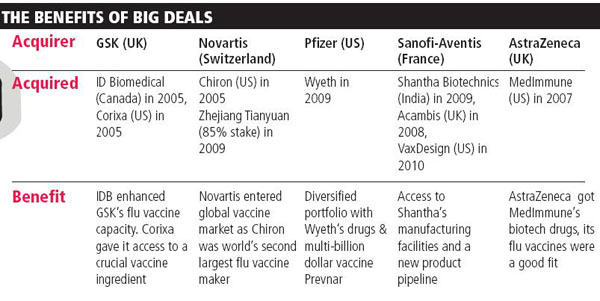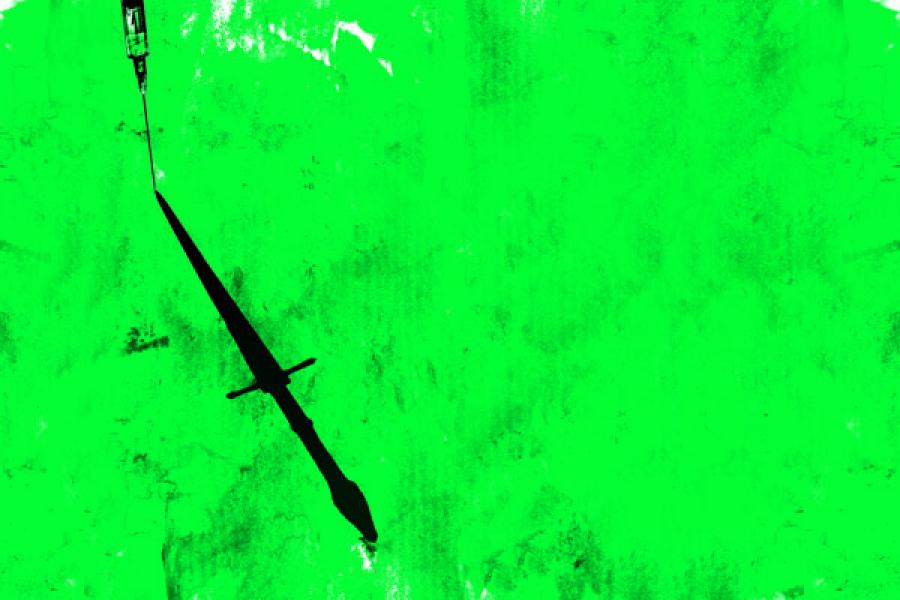
A Shot of India: The Vaccine Market
Big pharma is looking for immunity from a fall in revenues as blockbuster drugs go off patent. They are finding it in Indian vaccine makers
The year was 2009. The company that was up for grabs was Shantha Biotech. And advances came from three big pharmaceutical companies. Eventually, France’s Sanofi-Aventis acquired the Hyderabad-based vaccine maker for $784 million. Now, once again the industry is buzzing with the news of Biological Evans (BE), another vaccine maker, being tipped as a takeover candidate. The most likely suitor this time is GlaxoSmithKline (GSK).
Both companies, however, remain non-committal: BE neither confirms nor denies the reports; GSK says it continues to evaluate potential acquisitions in emerging markets but is unable to comment “on any potential future business development opportunities”. GSK’s global vaccine business grew 24 percent compared to the 11.4 percent growth in its core pharmaceutical business in the last quarter. The only vaccine facility it has in India is a filling and packaging site in Nashik.
GSK is always looking for a strategic fit, says its India Managing Director Hasit Joshipura. “Any Indian company [that we may acquire] will only add back-end infrastructure facility to GSK. Since we [multinational companies] are the innovator companies, there’s no front-end [value addition] if such a deal ever happens.”
Sanofi had a similar logic when it acquired Shantha. Since all private sector Indian vaccine manufacturers supply products to UN agencies and charitable foundations for global immunisation programmes, they possess world class manufacturing facilities that are complex to build and maintain. This makes Indian companies attractive acquisition targets for two reasons: Assured income from exports and certified facilities that can cater to large global market needs.
It’s a winning combination for an industry that is struggling to supplement revenue that is headed southward because of loss of patent exclusivity on blockbuster drugs. In contrast, vaccines — which were neglected by big drug companies because they gave low margins — are now seen as a steady source of income. More specifically, the party really began with Wyeth’s Prevnar, a vaccine for childhood infections, and Merck & Co’s Gardasil for cervical cancer. Around 2005, they turned out to be billion-dollar products and others decided to gatecrash by snapping up vaccine assets around the world.
The party is expected to get merrier as advancements in technology and growing population needs are pushing the biomedical community to develop therapeutic (e.g. cancer, meningitis) and adult vaccines along with the traditional preventive and paediatric jabs.
With the global vaccine market estimated to reach $40 billion by 2015 (influenza vaccines alone will account for $7 billion), Indian vaccine makers find themselves at a crucial crossroads. For the first time they will compete with Chinese companies in the export market, even as they continue to navigate the muddy waters of Indian public health policies and poor delivery systems. Still peddling me-too products (generic vaccines), they now have competition from big pharma eager to enhance its foothold in India.
New Threats
Most Indian companies get the bulk of their revenue from exports to UN agencies, charitable organisations including the Bill & Melinda Gates Foundation and the Global Alliance for Vaccine and Immunisation, and several country-specific immunisation programmes. But the virtual monopoly that Indian companies have enjoyed there, will now be challenged by China.
For the first time, in March, the Chinese national regulatory authority received World Health Organization’s (WHO) ‘pre-qualification’, a certification that allows it to approve locally manufactured vaccines to compete for UN tenders. This is a “huge concern”, rather a warning for Indian companies, says Cyrus Poonawalla, chairman of Poonawalla Group that owns India’s largest vaccine company, Serum Institute, Pune. “I have serious reservations about the quality of Chinese products, but they will give us tough competition as by the time any poor quality product gets detected, companies normally end up garnering swift business.”
But past performance isn’t always a good metric for future business. Last July, Shantha’s pentavalent (five-in-one) vaccine was removed from the WHO’s pre-qualification list for poor quality, knocking off $340 million from Sanofi’s estimated earnings between 2010 and 2012 from this vaccine.
This might prove detrimental to Indian companies. There is a likelihood of an increase in regulatory scrutiny of vaccines from India after this disqualification, says Anantharaman Kavassery Viswanathan, market research company Datamonitor’s lead healthcare analyst in India. This, along with the increasing manpower cost in India, might work to the advantage of Chinese vaccine manufacturers for getting their vaccines pre-qualified, he cautions. Chinese products are exerting pricing pressure in the domestic market as well. “While Indian companies can’t sell a single vial in China, Chinese vaccines are sold here without any quality control,” says Krishna M. Ella, chairman and managing director of Bharat Biotech, another Hyderabad-based company that is speculated to be a buyout candidate every now and then. But Ella, a scientist-turned-entrepreneur, says he’s aggressively pursuing new technologies and “cashing out” at this stage is out of the question.

Between 2008 and 2010, primarily driven by new product launches, Bharat Biotech’s revenue grew more than threefold to Rs. 272 crore (according to the latest BioSpectrum-ABLE industry report). A good show, but Ella thinks the current “cannibalisation” among Indian companies, as they all go after the same set of vaccines, is killing value. To address that, he recently set up the National Vaccine Manufacturers Association and serves as its founding president. He is trying to persuade the three public sector units — Pasteur Institute in Coonoor in Tamil Nadu, Indian Immunologicals in Hyderabad, and the Central Research Institute in Kasauli, Himachal Pradesh — to join the association, but they are reluctant.
Ella is exasperated: “Don’t public sector units need to make money, invest in R&D and drive new products?”
Primitive Policies
If China is supporting its local manufacturers by promoting their products in the national immunisation programmes, the South Korean government is going to the extent of financing equipment and providing leased land for facilities. Perhaps as a fall-out of the recent pandemic flu scares, good-quality vaccine-manufacturing facilities are seen as a health security. “There’s a new-found nationalism around it,” says Ella, who is exploring marketing opportunities in South Korea. In late 2009, Swiss pharma company Novartis opened a new flu vaccine facility in North Carolina, US, that will go into full commercial production in 2013 and is supported by the US health and services department. In India, says Ella, private companies don’t want any financial help, only strategic support through policy.
That sounds pragmatic for an industry that recorded Rs. 2,180 crore in sales in 2010 but has potential for much more, as India limps behind countries like Pakistan and Bangladesh in vaccine penetration. On that account, says Rajesh Jain, joint managing director of Panacea Biotec, the Indian vaccine policy is nothing short of “primitive”. Even as the rest of the world, including organisations like the UNICEF and WHO, follows a two to three year procurement cycle, the Indian Ministry of Health and Family Welfare doesn’t even have an annual cycle. There’s no co-ordination between demand forecasting and procurement.
“The new financial year has begun but no manufacturer has been informed about the likely demand; there’s no tender allotment yet,” says Poonawalla. Since vaccines take six to eight months to produce, short procurement notices create artificial shortages in the market. A pertinent example, says Ella, is the recent shortage of typhoid vaccine that the health department brought to public notice. “Bharat Biotech is the largest producer of typhoid vaccine in the world. Do you think we can’t serve the local market? But our health authorities don’t even know what their own companies can produce,” he says.
Former health secretary K. Sujatha Rao wanted to develop a two-year procurement cycle but before she could implement anything, her term got over, says K.V. Balasubramaniam, managing director of Indian Immunologicals, a subsidiary of the National Dairy Development Board. Due to national commitment, his company can’t export even a single dose if there’s any shortage in the country. And the skewed procurement policy makes sure that there’s perennial shortage.
Balasubramaniam says he can be content even with that if the health delivery system is streamlined so that manufacturers don’t get a rap for “programme errors” in vaccine administration. In early April, the state drug regulatory body in Andhra Pradesh stopped Indian Immunologicals from making measles vaccines after adverse events and deaths were reported from Gujarat. The Drug Controller General of India inspected its facilities and took eight samples from different locations. “Everything was fine. The adverse event in Gandhidham was due to an adjuvant [a pharmacological ingredient that is added to vaccines to increase its effect] mix with the vaccine [the two need to be stored separately], which is the programme administrator’s fault,” says Balasubramaniam. He says even the cervical cancer HPV vaccine’s clinical trial that was halted last year had similar issues of “programme error”.
Special Secretary in the Ministry of Health and Family Welfare P.K. Pradhan agrees that “programme errors” are an issue and they need to be “minimised”. “But we cannot follow a longer procurement cycle because it’s difficult to forecast raw material cost and include clauses in the tender. UNICEF is able to do so because it procures very high volumes.” The volumes could be higher in India as well if the coverage was to increase. Here too China appears miles ahead. “Its national immunisation programme is evolving much faster. The Chinese health authorities are organised to protect the entire birth cohort (the number of people born in a year or particular period), the calls for tenders are high and capacity needs to meet requirements,” says a spokesperson at GSK Biologicals, UK.
Will M&As Bring Change?

The Chinese practices sound like Indian companies’ wish list, but one that is unlikely to be fulfilled, at least in the near future.
Unless India has a national vaccine policy and unless there’s a core health care team in the government, where health secretaries don’t change every 18 months, serious change is difficult to bring about. “That might not happen before 2012-13, but as chairman of the biotech sub-committee of the Confederation of Indian Industry, I am going to drive this [national policy] agenda from ground up,” says Jain.
Surprisingly, Jain isn’t worried about “multinationals eating away Indian companies”. One reason could be that he has a joint venture with the American vaccine maker Chiron. “If three [Indian companies] go, 30 more will come,” he says. In fact, he says, MNCs bring a level of competency, capacity building, systems, processes and human resources practices which, on the whole, benefit the industry. “Even their dialogue and engagement with the government is of a certain quality. They raise issues in a manner that brings out effective policy changes in the government,” he says.
Still, MNCs may find it tough to keep prices low. If Indian companies get acquired — and the ones that are not strong in R&D will be the first to go — there will be less and less supply of low-cost vaccines, says Balasubramaniam. “In [vaccine for] foot and mouth disease [in animals] we have seen it firsthand. MNCs have come and gone, we have kept our prices.”
For some, it’s also a question of addressing the country’s needs.
No MNC will develop encephalitis, dengue, or chikungunya vaccine for India. “It’s sad that we are still using oral polio vaccine, when all MNCs have the injectable vaccine which they don’t bring to the Indian market,” says Balasubramaniam.
(This story appears in the 20 May, 2011 issue of Forbes India. To visit our Archives, click here.)
-
 Ankush
AnkushIts sad that we are still using oral polio vaccine, when all MNCs have the injectable vaccine which they don't bring to the Indian market; says Balasubramaniam. Either Mr Balasubramaniam is ill informed or doesn't want to face the fact that there are 2 IPV brands available in India which can easily be included in d national immunization program replacing OPV, provided d government agrees.
on Mar 30, 2012 -
 Vishwanath
VishwanathMr Jain of Panacea says if 3 go 30 will come. He should tell us how many new vaccine makers have come up in the last 8-9 years. It's not easy to set up such companies but then it's also not easy to be a manufacturer in this country, more so of healthcare goods. Look at medical devices, India doesn't even have a proper regulatory regime for it.
on May 11, 2011















